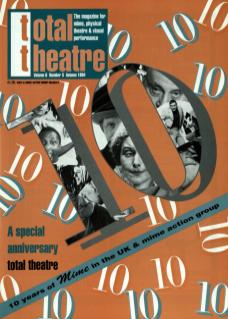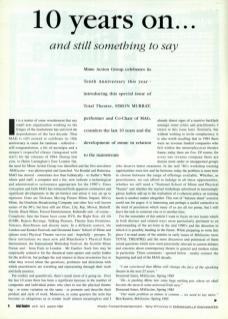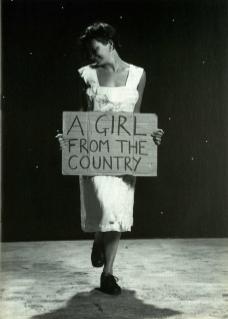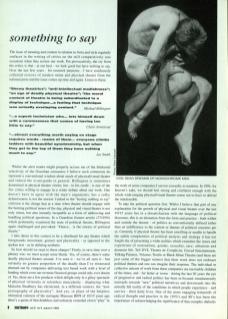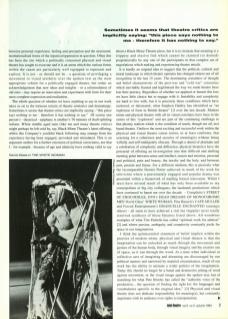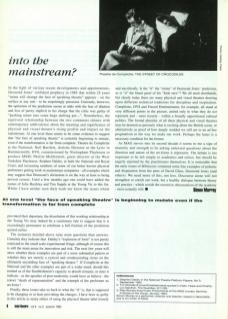It is a matter of some wonderment that any small arts organisation working on the fringes of the mainstream has survived the depredations of the last decade. That MAG is still around to celebrate its 10th anniversary is cause for cautious – collective – self-congratulation, a bit of nostalgia, and a minute's respectful silence (integrated with text?) for the veterans of 1984. During that year, in Helen Lannaghan's East London flat, the need for Mime Action Group was identified and the first newsletter – MAGazine – was photocopied and launched. Via Kendal and Battersea, MAG has moved – sometimes less than balletically – to Sadler's Wells where paid staff, a computer and a fax, now indicate a technological and administrative seriousness appropriate for the 1990s. Since conception and birth, MAG has witnessed both apparent continuities and significant developments in the artform(s) and artists it was set up to represent. Gone are Trickster, Moving Picture Mime, Impact, Mivvy Mime, the Omelette Broadcasting Company and other less well known names of the 80s, but here still are Glass, Lily, Rae, Mowat, Berkoff, Trestle, Black Mime, Forced Entertainment, Kaboodle, and of course Complicite. Into the frame have come DV8, the Right Size, dA dA dUMB, Rejects Revenge, Talking Pictures, Theatre Sans Frontiéres, Volcano, Benchtours, and dozens more. In a different context, the London and Kendal Festivals and Desmond Jones' School of Mime and (please note) Physical Theatre survive and – hopefully – prosper. To these institutions we must now add Manchester's Physical State International, the International Workshop Festival, the Scottish Mime Forum and – from Paris to London – Mr Gaulier. Such lists may be empirically seductive for the theatrical train-spotter and useful fodder for the archivist, but perhaps the real interest in these inventories lies in what they reveal about the questions, problems and directions with which practitioners are wrestling and representing through their work and daily practice.
Put crudely and quantitatively, there's much more of it going on. Over the last ten years there has been a significant increase in the number of companies and individual artists who elect to use the physical theatre tag – or some variation on the same – to promote and describe their product and style of work. Moreover, in some quarters the term has become so ubiquitous as to render itself almost meaningless, and I already detect signs of a reactive backlash amongst some critics and practitioners. I return to this issue later. Similarly, but without wishing to invite complacency, it is also worth recalling that in 1984 there were no revenue funded companies who fell within the mime/physical theatre frame: today there are five. Of course, for every one revenue company there are dozens more under or unsupported groups who deserve better treatment. In the mid 80s workshop training opportunities were few and far between; today the problem is more how to choose between the range of offerings available. Whether, as practitioners, we can afford to indulge in all these opportunities, whether we still need a ‘National School of Mime and Physical Theatre’, and whether the myriad workshops advertised in increasingly glossy leaflets add up to the realisation of a coherent policy on training needs is another matter altogether. This sort of ‘balance sheet’ exercise could run for pages: it is interesting and perhaps a useful corrective to the kind of pessimism which many of us are all too prone to, but I will leave the task to someone else or to another time.
For the remainder of this article I want to focus on two issues which in both distinct and related ways seem particularly pertinent to an understanding of the artform in the mid 1990s and the direction in which it is possibly heading in the future. While preparing to write this piece I re-read many of the articles in early issues of MAGazine (now Total Theatre) and the more discursive and polemical of them raised questions which now seem presciently relevant to current debates and concerns about contemporary theatre in general and modern mime in particular. Three comments – quoted below – neatly connect the beginning and end of the MAG decade:
‘I am convinced that Mime will change the face of the speaking theatre in the next 25 years.’ Desmond Jones, MAGazine, Spring 1985.
‘He... is pushing Mime into some huge melting pot, where we shall become the meat in some universal Irish stew.’ Desmond Jones, MAGazine, Spring 1985.
‘Our main problem as mimes is content ... we need to say more.’ Ben Keaton, MAGazine, Spring 1985.
Something to say
The issue of meaning and content in relation to form and style regularly surfaces in the writing of critics on the still comparatively rare occasions when they review our work. Put provocatively, the cry from the critics is that at our best – we look good but have nothing to say. Over the last few years for research purposes, I have assiduously collected reviews of modern mime and physical theatre from the national press and the issue comes up time and again. Listen to these:
‘Showy theatrics’; ‘anti-intellectual modishness’; ‘an age of deadly physical theatre’; ‘the moral content of theatre is being subordinated to a display of technique... a feeling that technique was actually overlaying content’. – Michael Billington
‘...a superb technician who... lets himself down with a carelessness that comes of having too little to say.’ – Claire Armistead
‘...almost everything worth saying on stage requires words, reams of them... everyone climbs ladders with beautiful synchronicity, but when they get to the top of them they have nothing much to say.’ – Les Smith
Whilst the alert reader might properly accuse me of the blinkered selectivity of the Guardian consumer, I believe such comments do represent a conventional wisdom about much of physical/visual theatre and indeed the avant-garde in general. Billington is sometimes demonised in physical theatre circles, but to his credit – is one of the few critics willing to engage in a wider debate about our work. One doesn't have to agree with the man's arguments, but a sulky defensiveness is not the answer. Linked to the ‘having nothing to say’ criticism is the charge that at a time when theatre should engage with the burning political issues of the day, physical and visual theatre is not only silent, but also innately incapable as a form of addressing and handling political questions. In a Guardian feature article (27/4/94) which pertinently examined the state of political theatre, Billington again challenged and provoked: ‘Dance... is the enemy of political theatre, I take dance in this context to be a shorthand for any theatre which foregrounds movement, gesture and physicality – as opposed to the spoken text – as its defining aesthetic.’
So how should we react to these charges? Firstly, to save time over a phoney war, we must accept some blame. Yes, of course, there's some deadly physical theatre around. I've seen it – we've all seen it – but certainly no greater proportion of the deadly than I've witnessed churned out by companies delivering text-based work with a level of funding which even our revenue financed groups could only ever dream of. Yes, there are a few products which delight only in a glitzy spectacle of physical virtuosity or relentless muscularity, displaying what Malcolm Bradbury has christened, in a different context, the ‘new pornography of physicality’. And yes, in place of the helpless whimsical cuteness of the surrogate Marceau BIPS of 10/15 years ago there's a quota of that deathless and tediously extended clown ‘play’ in the work of some companies I am too cowardly to mention. In 1994, for heaven's sake, we should feel strong and confident enough with the whole wide-ranging physical/visual theatre canon not to have to defend the indefensible.
Sometimes it seems that theatre critics are implicitly saying: ‘this piece says nothing to me – therefore it has nothing to say’
To take the political question first. Whilst I believe that part of any explanation for the growth of physical and visual theatre over the last 10/15 years lies in a dissatisfaction with the language of political discourse, this is an alienation from the form and practice – both within and outside the theatre – of politics as conventionally defined rather than an indifference to the content or themes of political concerns per se. Certainly, if physical theatre has been unwilling or unable to handle the subtle complexities of political analysis and strategy it has not fought shy of presenting a wider politics which examines the issues and experience of nationalism, gender, sexuality, race, urbanism and domestic life. Tell DV8, Theatre de Complicite, Forced Entertainment, Talking Pictures, Volcano, Trestle or Black Mime Theatre (and these are just some of the bigger names) that their work does not embrace political themes and one can imagine their response. The individual or collective auteurs of work from these companies are inevitably children of the times, and – for better or worse during the last twenty years the eye of progressive and radical politics has been refocused simultaneously outwards towards ‘new’ political narratives and downwards into the actually felt reality of the conditions in which people experience – and survive – their daily lives. One of the more engaging leitmotifs of radical thought and practice in the 1970s and 80s has been the importance of acknowledging the significance of that complex dialectic between personal experience, feeling and perception and the structured, institutionalised forms of the injustice/oppression in question. Often this has been the site which a politically concerned physical and visual theatre has sought to excavate and it is an arena which the various forms within the canon are particularly well equipped to represent and explore. It is not – or should not be – a question of privileging a movement or visual aesthetic over the spoken text as the most appropriate vehicle for a politically engaged theatre, but rather an acknowledgement that new ideas and insights – or a reformulation of old ones – may require an innovation and experimention with form for their most complete expression and realisation.
The whole question of whether we have anything to say in our work takes us on to the tortuous terrain of theatre semiotics and dramaturgy. Sometimes it seems that theatre critics are implicitly saying: ‘this piece says nothing to me – therefore it has nothing to say’. Of course one person's – theatrical – epiphany is another's 70 minutes of skull-splitting tedium. White middle-aged men (like me and many theatre critics) might perhaps be left cold by, say, Black Mime Theatre's latest offering, whilst this Company's youthful black following may emerge from the experience having been engaged, provoked and stimulated. This is an argument neither for a further extension of political correctness, nor that I – for example – because of age and ethnicity have nothing valid to say about a Black Mime Theatre piece, but it is to (re)state that meaning is a slippery and elusive fish which cannot be claimed (or denied) proprietorially by any one of the participants in that complex set of negotiations which making and experiencing theatre entails.
It is hardly an original idea to suggest that the political, cultural and moral landscape in which theatre operates has changed almost out of all recognition in the last fifteen years. The dominating certainties of thought and belief characteristic of the post-war and ‘cold war’ consensus which inevitably framed and legitimised the way we made theatre have lost their potency. Regardless of whether we applaud or lament this loss we have little choice but to engage with it. Instability and complexity are hard to live with, but it is precisely these conditions which have nurtured, or detonated, what Stephen Daldry has identified as ‘an explosion of form in British theatre’ [1] over the last decade. Modern mime and physical theatre with all their visual correlates have been in the centre of this ‘explosion’ and are part of the continuing challenge to that phoney realism which is the condition of much, though not all, text-based theatre. I believe the most exciting and successful work within the physical and visual theatre canon resists, or at least confronts, that yearning for a coherence and security of meaning(s) without being wilfully and self-indulgently obscure. Through a denial of platitude and a celebration of complexity and difference, physical theatre(s) have the potential of offering an investigation into that difficult and shifting meeting point between sense and intellect, reason and emotion, personal and political, pain and beauty, the tawdry and the holy, and between past, present and future. For a different medium, this is precisely what the incomparable Dennis Potter achieved in much of his work for television where a passionately engaged and popular drama was presented within a framework of startling formal innovation. Whilst I must have missed much of what has only been available to my cosmopolitan or big city colleagues, the landmark productions which have continued to haunt me over the decade – Complicite's Street of Crocodiles, DV8's Dead Dreams of Monochrome Men, David Glass' White Woman, Pina Bausch's Cafe Muller and Forced Entertainment's Emanuelle Enchanted (amongst others) – all seem to have achieved a rich but (happily) never totally resolved synthesis of those binaries listed above. All wondrous examples of what Tim Etchells has called ‘spiritual work for atheists’ [2] and where passion, ambiguity and complexity constantly jostle for space in our imaginations.
I think the quintessential statement of belief implicit within the practice of modern mime, physical and visual theatre is that the imagination can be unlocked as much through the movement and gesture of the human body, through visual imagery and the creative use of space, as it can through the word. At a time when individual or collective acts of imagining and dreaming are discouraged by our political masters and narrowed by material circumstances, much of our work has the ability to animate a wider politics of the imagination. Today this should no longer be a banal and destructive pitting of word against movement, or the visual image against the spoken text, but of searching for what Pete Brooks has called the ‘authentic voice of the production... the question of finding the right kit: the languages and vocabularies specific to the original idea’. [3] Physical and visual theatre does not abdicate responsibility for meaning(s), but constantly negotiates with its audience over rights to interpretation.
Into the mainstream?
In the light of various recent developments and appointments, Desmond Jones' confident prophecy in 1985 that within 25 years ‘mime will change the face of speaking theatre’ appears – on the surface at any rate – to be surprisingly prescient. Curiously, however, the optimism of the prediction seems at odds with the fear of dilution and loss of purity implicit in his charge that the critic was guilty of ‘pushing mime into some huge melting pot...’. Nonetheless, the equivocal relationship between the two comments chimes with contemporary ambivalence about the meaning and significance of physical and visual theatre's rising profile and impact on the mainstream. At one level there seems to be some evidence to suggest that ‘the face of speaking theatre’ is certainly beginning to mutate, even if the transformation is far from complete. Theatre de Complicite at the National; Neil Bartlett, Artistic Director at the Lyric in Hammersmith; DV8, commissioned by Nottingham Playhouse to produce MSM: Phelim McDermott, guest director at the West Yorkshire Playhouse; Stephen Daldry, at both the National and Royal Court; and increasing numbers of some of our better known physical performers getting work in mainstream companies – all examples which may suggest that Desmond's divination is on the way at least to being proved correct. Until a few months ago one could have added the names of Julia Bardsley and Tim Supple at the Young Vic to this list. Whilst I have neither seen their work nor know the issues which provoked their departure, the dissolution of this working relationship at the Young Vie may indeed be a cautionary tale to suggest that it is exceedingly premature to celebrate a full fruition of the prediction quoted earlier.
At one level ‘the face of speaking theatre’ is beginning to mutate even if the transformation is far from complete
The instances detailed above raise more questions than answers. Certainly they indicate that Daldry's ‘explosion of form’ is not purely restricted to the small-scale experimental fringe, although of course this is still the main arena for innovation and risk. The next few years will show whether these examples are part of a more substantial pattern or whether they are merely a cynical and condescending rictus on the ultimately unyielding face of ‘speaking theatre’. If Complicite at the National and the other examples are part of a wider trend, should this remind us of the Establishment's capacity to absorb irritants, or does it indicate – as the apostles of post-modernity would have us believe – the (slow) ‘death of representation’ and the triumph of the performer as artform?
Finally, these issues take us back to what the ‘it’ is, that is supposed to be changing or at least provoking the changes. I have been as guilty in this article as many others of using the physical theatre label loosely and uncritically. Is the ‘it’ the ‘mime’ of Desmond Jones' prediction, or is ‘it’ the bland gruel of his ‘Irish stew’? We all need shorthands, but clearly today there are many physical and visual theatres drawing upon different technical traditions for discipline and inspiration. Complicite. DV8 and Forced Entertainment, for example, all stand at very different points in the picture, united only in what they do not represent and – more loosely – within a broadly oppositional cultural politics. The formal plurality of all these physical and visual theatres may be deemed as precisely what is exciting about the British scene, or alternatively as proof of how deeply wedded we still are to an ad hoc pragmatism in the way we make our work. Perhaps the latter is a necessary condition for the former.
As MAG moves into its second decade it seems to me a sign of maturity and strength to be asking awkward questions about the direction and nature of the artforms it represents. The debate is too important to be left simply to academics and critics, but should be eagerly enjoined by the practitioners themselves. It is noticeable that the early issues of MAGazine contained some fine examples of polemic and disputation from the pens of David Glass, Desmond Jones (and others). We need more of this, not less. Discourse alone will not strengthen or enrich our work, but a healthy dialogue between theory and practice – which avoids the excessive obscurantism of the academy – most certainly will.
References:
1. Stephen Daldry in the National Theatre Platform Papers, No 3, September 1992
2. Tim Etchells (Forced Entertainment) quoted in ‘Faith, Hope and Charity’, Lyn Gardner, The Guardian, 9/11/93
3. Pete Brooks (Insomniac Productions) at the MAG London seminar A Sense of the Visual, January 1994.
Simon Murray is a performer, director and teacher, based in Newcastle, and is Co-Chair of MAG.
